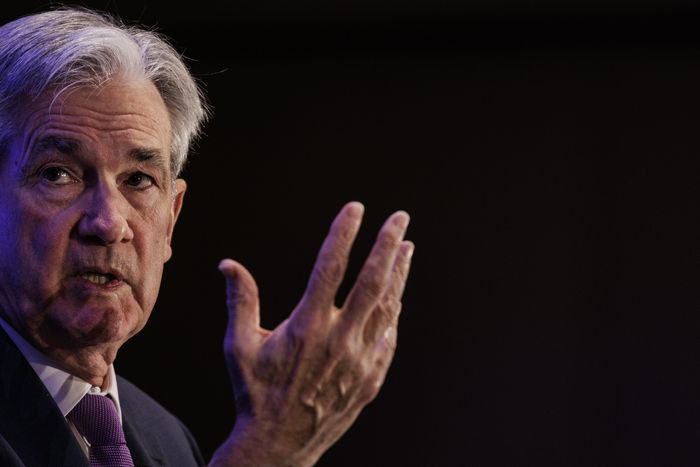
Federal Reserve Chairman Jerome Powell
Samuel Corum/Getty Images
All three U.S. stock benchmarks dropped by the most in about a week on Monday, with Dow industrials off by more than 200 points, after Federal Reserve Chairman Jerome Powell left the door open to the prospect of bigger rate hikes to bring down inflation.
Shares of Boeing Co. BA, -3.59%, the Dow’s biggest loser, fell after a Boeing 737 passenger plane operated by China Eastern Airlines and carrying 132 people slammed into the mountains of southern China.
What happened?
- The Dow Jones Industrial Average DJIA, -0.58% finished lower by 201.94 points, or 0.6%, at 34,552.99 after dropping as much as 413 points. Dow industrials had their largest one-day point and percentage decline since March 11, snapping a five-trading-day winning streak, according to Dow Jones Market Data.
- The S&P 500 SPX, -0.04% closed slightly down by 1.94 points, or less than 0.1%, at 4,461.18.
- The Nasdaq Composite COMP, -0.40% finished lower by 55.38 points, or 0.4%, at 13,838.46.
- It was the S&P 500’s and Nasdaq Composite’s largest one-day point and percentage declines since March 14.
What drove markets?
All three major stock indexes dropped and Treasurys aggressively sold off on Monday as Powell, speaking to the National Association for Business Economics, repeated that the central bank could deliver rate increases of larger than 25 basis points each at future meetings if policy makers deem it necessary in their fight to control inflation.
The Fed chief underlined the need to tighten monetary policy at a quick pace, adding that upward pressure on prices from the invasion of Ukraine comes at a time of “already too high inflation.”
“If we conclude that it is appropriate to move more aggressively by raising the federal funds rate by more than 25 basis points at a meeting or meetings, we will do so,” he said.
Powell also pushed back against fears the Fed can’t aggressively raise rates without tipping the economy into recession, arguing that the central bank previously achieved soft landings as it tightened policy significantly in 1965, 1984 and 1994.
Read: Jerome Powell leaves door open for rate hikes larger than 25 basis points
“What he did was underscore the flexibility that the Fed has and make it clear the Fed could hike faster and by a greater amount,” said Marc Chandler, chief market strategist at Bannockburn Global Forex, in a phone interview. “The stock market didn’t like it and neither did the bond market.”
Until Monday, equity markets in the U.S. had held up relatively well to the start of the Federal Reserve’s first rate-hike campaign since 2015-2018, which included a quarter-point hike last week and the prospect of a total of 10 or 11 quarter-point hikes through 2023.
Earlier in the day, Atlanta Federal Reserve Bank President Raphael Bostic, a nonvoting policy maker this year, told the National Association for Business Economics that “elevated levels of uncertainty” have tempered his confidence that an “extremely aggressive rate path” is appropriate for the Fed.
Developments in Russia’s war on Ukraine also remained on investors’ radar. On Monday, Ukrainian officials rejected a Russian demand that their forces in Mariupol surrender as the U.K. Ministry of Defence said that heavy fighting continues north of Kyiv. Meanwhile, the U.S. is sending secretly-acquired Soviet-made air defense equipment to Ukraine.
In a pandemic-related update, Dr. Anthony Fauci, President Joe Biden’s chief medical adviser, said that the BA.2 subvariant of the omicron variant of the coronavirus that causes COVID-19 will probably cause an uptick in U.S. cases similar to the one currently occurring in Europe.
Which companies were in focus?
- Boeing BA, -3.59% shares finished 3.6% lower after China state media reported that a 737 airliner crashed. The plane was a 737-800, not the 737 Max, which has yet to resume commercial flying in China, according to The Wall Street Journal.
- In deal-making news, Warren Buffett’s Berkshire Hathaway Inc. BRK.A BRK.B struck an $11.6 billion, all-cash deal to buy property-and-casualty reinsurance company Alleghany Corp. Y, the companies announced Monday. The $848.02 per share price is 1.26 times book value as of Dec. 31 and a 29% premium to its average price over the last 30 days, the companies said. Alleghany shares closed up by 25% at $844.60, while Berkshire Hathaway’s B shares finished 2.1% higher.
- Nielsen Holdings PLC NLSN rejected a roughly $9 billion takeover offer from a private-equity consortium, saying that it undervalues the TV-ratings company. Nielsen shares closed down by 6.9%.
- Private-equity firm Thoma Bravo LP reached a deal to buy software maker Anaplan Inc. PLAN, +27.69% for $10.7 billion, The Wall Street Journal reported, citing people familiar with the matter. Anaplan shares finished 28% higher.
How did other assets fare?
- The yield on the 10-year Treasury note TMUBMUSD10Y, 2.294% rose 16.9 basis points to 2.315%. That’s the highest level since May 24, 2019, and the largest one-day gain in two years, based on 3 p.m. levels, according to Dow Jones Market Data. Yields and debt prices move opposite each other.
- The ICE U.S. Dollar Index DXY, +0.25%, a measure of the currency against a basket of six major rivals, was up 0.3%.
- Bitcoin BTCUSD, -0.20% declined 0.2% to trade at $41,215.
- West Texas Intermediate crude for April delivery CLJ22, +7.55% rose $7.42, or 7.1%, to settle at $112.12 a barrel on the New York Mercantile Exchange; the settlement was the highest for a front-month contact since March 8, according to FactSet data. April gold futures settled at $1,929.50 an ounce, up 20 cents for the Comex session.
- The Stoxx Europe 600 SXXP, +0.04% closed slightly higher, up by less than 0.1%, while London’s FTSE 100 UKX, +0.51% finished up by 0.5%.
- The Shanghai Composite SHCOMP, +0.08% finished 0.1% higher, while the Hang Seng Index HSI, -0.89% fell 0.9% in Hong Kong. Japan’s Nikkei 225 NIK, +0.65% was closed for a holiday.
— Steve Goldstein contributed to this article.


